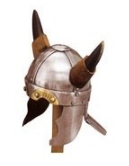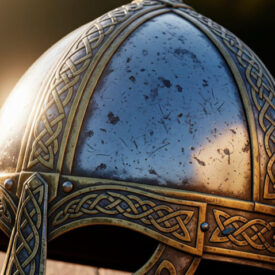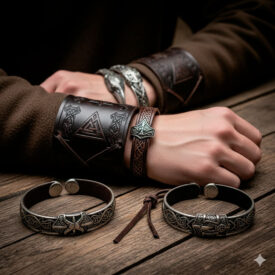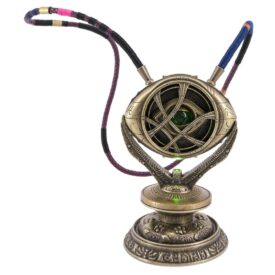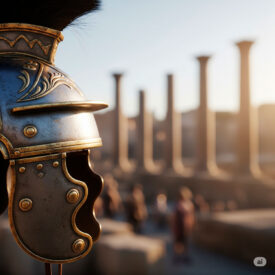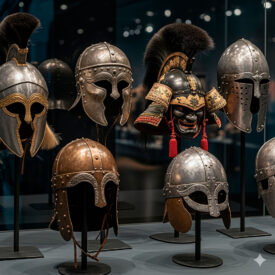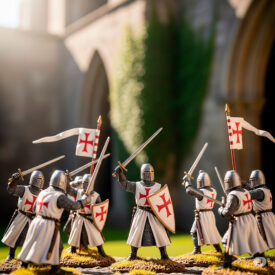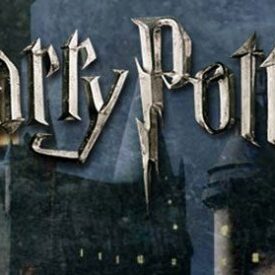Collecting is a hobby that goes far beyond the mere accumulation of objects. It is a passion that reflects personal taste, patience in the search for unique pieces, and, above all, a fun and enriching way to connect with history. Within this vast universe, helmet miniatures have become one of the most captivating categories, offering a miniature window into the evolution of warfare and armor throughout the centuries.
A collection of period helmet miniatures is much more than a simple set of replicas. Each meticulously crafted piece captures the essence and details of original helmets used by warriors from different civilizations and periods. This allows enthusiasts to appreciate the subtle yet significant differences between the helmet of a Spanish conquistador, a Roman legionary, or a fierce Viking. Helmets, as one of the most crucial elements of military equipment, had the primary function of protecting the soldier’s head, but their shape, materials, and ornamentation largely depended on the region, era, and combat tactics employed. Hence lies the beauty of this variety: being able to analyze each piece, the history it contains, what it represents, the era in which it was used, its effectiveness on the battlefield, and even its evolution over time.
—
Historical Helmet Miniatures: A Journey Through Antiquity
Greek and Spartan Helmets in Miniature: Symbols of Valor
The helmets of ancient Greece, and particularly the Spartan ones, immediately evoke images of legendary warriors and epic battles. These ancient helmet miniatures allow us to appreciate the robustness and functionality of designs such as the Corinthian helmet, which covered almost the entire head and face, leaving only openings for the eyes and mouth. In some Greek city-states, such as Sparta, elite leaders and warriors often wore bronze helmets, a resistant material that offered superior protection. Although today we associate heavy armor with all infantry, investment in equipment varied considerably, with lower-ranking soldiers sometimes receiving simpler armor, while the elite wore high-quality and often decorated pieces.
Roman Helmet Miniatures: Ingenuity and Discipline of the Empire
The discipline and organization of the Roman Empire are also reflected in the standardization and evolution of its armor. Roman helmet miniatures are very popular, with the imperial or Gallo-Imperial helmet being one of the most recognizable. Easy to identify by its distinctive ear protections (pteruges) and, in later versions, by the iconic plume or crest that indicated the wearer’s rank. These helmets were often based on designs made by skilled Gallic blacksmiths.
Roman helmets were primarily constructed of iron or brass, and incorporated small decorative details that, while subtle, reflected the aesthetics of the time. To improve comfort and protection, many of these helmets included internal wool fabric padding, lined linen pieces, or even leather to cover the metal edges. It is crucial to remember that helmets were always made according to the materials available at each time and, more importantly, adapted to the weapons and tactics used in each specific combat.
Gladiator Helmets in Miniature: Splendor and Struggle
The world of gladiators, with its mix of spectacle, brutality, and honor, has also bequeathed us a rich variety of distinctive helmets. Gladiator helmet miniatures are especially interesting because, in many cases, the type of helmet they wore was one of the main ways to differentiate between the different classes of fighters: the murmillo, the Thracian, the secutor, the Samnite, among others. Not only their weapons, but also their armor and helmets, were fundamental to their identity in the arena.
Great importance was given to the fighting style and armor, not only for the protection they offered, but also because most gladiators were slaves or prisoners of war. For them, combat was the only way not only to stay alive, but to aspire to freedom, fame, and even a good economic position. Each helmet therefore reflected an aspect of their combat style and, ultimately, their destiny.
—
Medieval Helmet Miniatures and Beyond: The Evolution of Protection
Viking and Crusader Helmets in Miniature: Conquest and Faith
The Middle Ages, a period of constant wars and profound social changes, saw the emergence of some of the most iconic and functional helmets in history. Medieval helmet miniatures allow us to explore everything from the simple but robust conical helmets of the Vikings, often accompanied by nasal protection, to the complex closed helms of the Crusader knights.
Viking helmets, for example, were practical and effective, designed for the rapid and brutal warfare of the Nordic raiders. Their functionality was paramount. In contrast, the helmets of the Crusaders, such as the Great Helm or the bascinet, evolved to offer complete head and neck protection on the battlefields of Europe and the Holy Land. These helmets were not only tools of war, but also began to incorporate elements that reflected the identity of the knight and his lord, such as crests and articulated visors. Collectible helmet miniatures capture this rich diversity, allowing collectors to appreciate the evolution of design and craftsmanship.
Conquistador and Modern Era Helmets in Miniature
With the advent of gunpowder and changes in warfare tactics, helmets continued their evolution. Period helmet miniatures, spanning from the Renaissance to more recent periods, show how designs adapted to new threats and technologies. The helmets used by the Spanish conquistadors, such as the morions, are a perfect example of this transition. With their characteristic crests and wide brims, they offered protection against bladed weapons and projectiles, while also being a symbol of authority and power in the New World.
These helmets, often made of polished steel, were lighter and allowed for greater visibility than the heavy medieval helms, adapting to skirmishes and hand-to-hand combat in varied environments. The collection of period helmet miniatures offers the possibility of tracing this fascinating line of development, observing how armor transformed in response to the challenges of each new military era.
—
The Helmet Miniatures Collection: Beyond Aesthetics
Definition and Key Features
A helmet miniature is a scaled-down replica of a historical helmet. Its value lies not only in its compact size, ideal for limited spaces, but in the fidelity with which it reproduces the details of the original. Key features include:
- Historical Accuracy: The best miniatures are based on rigorous research to ensure that every line, every rivet, and every shape corresponds to the original helmet.
- Quality Materials: Although scaled down, many miniatures are made with materials that imitate the originals, such as metal (brass, pewter, alloys) to give them weight and an authentic feel.
- Artisanal Detail: The key to their appeal lies in meticulous attention to detail, from engravings and ornaments to the texture of the metal or the feathers of the plume.
- Variety of Eras and Cultures: Collections usually include helmets from different civilizations (Roman, Viking, medieval, samurai, etc.) and periods, reflecting historical diversity.
Practical and Technical Differences Between Real Helmet Types (and their Reflection in Miniature)
Each helmet, in its original version, was designed with a specific purpose, and these differences are appreciated even in collectible helmet miniatures:
- Protection vs. Visibility: Helmets like the Greek Corinthian offered maximum frontal protection but drastically reduced peripheral vision. Roman helmets, such as the imperial, sought a balance between protection and a wider field of vision.
- Materials: From Greek bronze and Roman iron, to medieval steel, the choice of material depended not only on availability, but also on metallurgical advancements and the type of predominant weapons. Miniatures often use metals that evoke these original materials.
- Shape and Ergonomics: The conical shapes of Nordic helmets to deflect blows, the articulated visors of medieval helms to allow eating or breathing, or the nasal protections that evolved into full visors. Every curve and protrusion had a function.
- Symbolic and Decorative Function: Beyond protection, many helmets served to distinguish military ranks or to reflect the opulence and status of the wearer, such as elaborate plumes or engravings. Period helmet miniatures often highlight these decorative elements.
—
Ideal Use Scenarios and Advantages of Collecting
Ideal for History and Model Enthusiasts
Helmet miniatures are perfect for:
- Amateur Historians: They allow for better visualization and understanding of the evolution of armor and military tactics over time.
- Model Enthusiasts: They are exquisite pieces that can serve as a focal point in dioramas or as part of thematic collections.
- Decoration with a Historical Touch: A set of historical helmet miniatures can add a touch of distinction and culture to any bookshelf, desk, or display case.
- Original Gifts: They are ideal gifts for history enthusiasts, epic fantasy lovers, or collectors in general.
Comparison of Advantages and Disadvantages
Advantages:
- Reduced Space: Their compact size makes them ideal for collectors with space limitations, allowing a large number of pieces to be grouped.
- Accessible Cost: They are generally more economical than full-size replicas, making collecting more accessible.
- Easy Maintenance: They require less care than larger pieces.
- Preserved Detail: Despite their size, quality pieces do not sacrifice detail or accuracy.
- Educational Value: They serve as a visual tool for learning about the evolution of armor and military history.
Disadvantages:
- Less Visual Impact: They do not have the same imposing presence as a 1:1 scale replica.
- Fragility: Some very detailed pieces can be delicate.
- Less Immersion: They do not offer the same tactile or “weight” sensation as a real replica.
—
Purchase and Use Recommendations by User Profile
For the Beginner Collector
If you are starting in the world of helmet miniatures, we recommend beginning with small thematic collections or varied sets that allow you to explore different eras and styles. Look for pieces that have a good balance between price and detail quality. An initial set combining a miniature Roman helmet, a miniature medieval helmet, and perhaps a conquistador helmet could be an excellent starting point. Prioritize historical accuracy and the robustness of the materials.
For the Expert and Historian
More experienced collectors and history enthusiasts often seek high-end pieces, with an exceptional level of detail and unwavering historical accuracy. For them, it is important to research the manufacturer, the materials used, and the replica’s precision. Often, they will focus on specific periods, such as ancient helmet miniatures from the Roman Empire, or on acquiring complete series that document the evolution of a particular helmet type. The search for rare or limited edition pieces can also be a goal.
For the Occasional Adventurer and Decoration Lover
If you are looking for one or two pieces to add a distinctive touch to your space or as an original gift, aesthetics and visual appeal will be key. You can opt for a mini Spanish conquistador helmet if that era appeals to you, or a miniature Spartan helmet for its symbolic strength. Consider where you will place the miniature and how it fits with your existing decor. Many of these pieces come with attractive bases that enhance their presentation.
—
The Legacy of Miniature Helmets
The collection of helmet miniatures is made up of pieces inspired by the armor of the bravest and most emblematic warriors in history, from Roman legionaries and fierce Vikings, to Crusader knights and daring conquistadors. Helmets are as old as war itself and were given the same fundamental use in all eras and cultures: to protect the warrior. However, as we have seen, there are profound differences in design, utility, and materials used for their manufacture. Each people and each civilization developed their own way of fighting and equipping themselves to ensure their survival, therefore, learning from defeats and victories, and improving their weapons and armor, became an obligation and a reflection of their ingenuity. These helmet miniatures allow us to closely appreciate that evolution and the art involved in their creation.
If you are looking to start or expand your own collection of these magnificent historical pieces, we invite you to explore our varied selection of period helmet miniatures, where you will find everything from historical helmet miniatures to ancient helmet miniatures that will delight any enthusiast.
You can see more helmet miniatures in our helmet miniatures section, and if you are interested in broadening your horizons in collecting, you can also explore other precious miniatures in our general miniatures collection.




